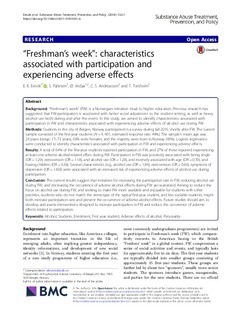| dc.description.abstract | Background
“Freshman’s week” (FW) is a Norwegian initiation ritual to higher education. Previous research has suggested that FW-participation is associated with better social adjustment to the student setting, as well as heavy alcohol use both during and after the event. In this study, we aimed to identify characteristics associated with participation in FW and characteristics associated with experiencing adverse effects of alcohol use during FW.
Methods
Students in the city of Bergen, Norway participated in a survey during fall 2015, shortly after FW. The current sample consisted of the first-year students (N = 4, 401, estimated response rate: 49%). The sample’s mean age was 24 years (range: 17–73 years), 65% were females, and the majority were born in Norway (93%). Logistic regressions were conducted to identify characteristics associated with participation in FW and experiencing adverse effects.
Results
A total of 64% of the first-year students reported participation in FW, and 27% of these reported experiencing at least one adverse alcohol-related effect during FW. Participation in FW was positively associated with being single (OR = 1.29), extroversion (OR = 1.18), and alcohol use (OR = 1.28), and inversely associated with age (OR = 0.70), and having children (OR = 0.36). Several characteristics (e.g., alcohol use (OR = 1.84), extroversion (OR = 0.60), symptoms of depression (OR = 1.60)) were associated with an increased risk of experiencing adverse effects of alcohol use during participation.
Conclusion
The current results suggest that initiatives for increasing the participation rate in FW, reducing alcohol use during FW, and decreasing the occurrence of adverse alcohol effects during FW are warranted. Aiming to reduce the focus on alcohol use during FW, and seeking to make FW more available and enjoyable for students with other priorities, students who do not match the stereotype of the typical first-year student, and less sociable students, might both increase participation rate and prevent the occurrence of adverse alcohol effects. Future studies should aim to develop and assess interventions designed to increase participation in FW and reduce the occurrence of adverse effects related to participation. | nb_NO |

